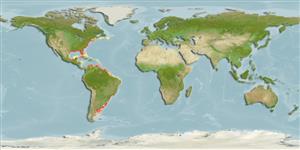Classification / Names
Common names from other countries
Main reference
Size / Weight / Age
Max length : 170 cm TL male/unsexed; (Ref. 7251); common length : 50.0 cm TL male/unsexed; (Ref. 3702); max. published weight: 51.3 kg (Ref. 4699); max. reported age: 43 years (Ref. 7188)
Length at first maturity
Lm 64.5, range 63 - ? cm
Environment
Marine; brackish; demersal; oceanodromous (Ref. 51243); depth range 10 - ? m
Climate / Range
Subtropical, preferred 23°C (Ref. 107945); 46°N - 51°S
Distribution
Western Atlantic: Nova Scotia (Ref. 7251) to Florida, Gulf of Mexico, the Antilles (uncommon), and the southern Caribbean coast; also from the Orinoco delta to Argentina.
Countries | FAO areas | Ecosystems | Occurrences | Introductions
Short description
Dorsal
spines
(total): 11;
Dorsal
soft rays
(total): 19-22;
Anal
spines: 2;
Anal
soft rays: 5 - 7. Silvery grey to very dark, young with 4 or 5 black vertical bars on sides, disappearing with growth; pelvic and anal fins usually dark. Chin with 5 pores and 10 to 13 pairs of small barbels along median edges of lower jaws and subopercles, increasing in length posteriorly. Gas bladder with numerous lateral appendages interconnected in a complicated pattern in adult. Sagitta semicircular and moderately thin (Ref 51721).
IUCN Red List Status (Ref. 115185)
Threat to humans
Harmless
Human uses
Fisheries: commercial; gamefish: yes; aquarium: public aquariums
More information
ReferencesAquacultureAquaculture profileStrainsGeneticsAllele frequenciesHeritabilityDiseasesProcessingMass conversion
Tools
Special reports
Download XML
Internet sources
Estimates of some properties based on models
Phylogenetic diversity index
PD50 = 1.0000 many relatives (e.g. carps) 0.5 - 2.0 few relatives (e.g. lungfishes)
Trophic Level
3.4 ±0.5 se; Based on diet studies.
Resilience
Medium, minimum population doubling time 1.4 - 4.4 years (K=0.17; tm=3-5; tmax=43)
Vulnerability
High vulnerability (60 of 100)
Price category
